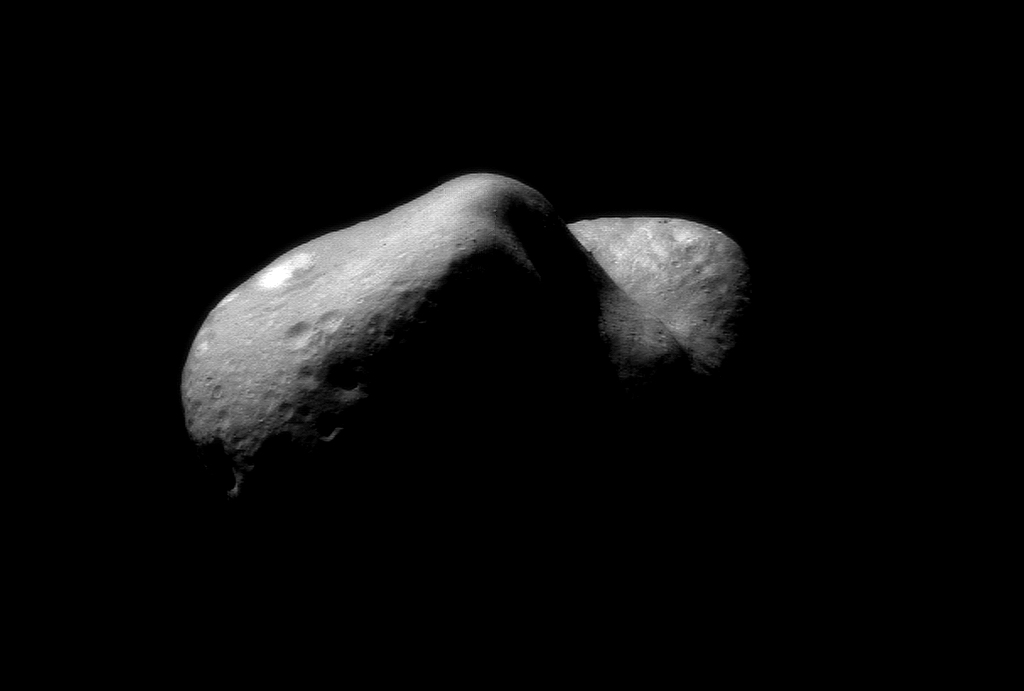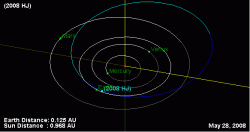A British astronomer has discovered a strange spinning object. The fact that it is spinning in itself is not strange, but the speed it is doing so has raised some eyebrows. The near-Earth asteroid 2008 HJ has been spotted spinning at a rate of one rotation every 42.7 seconds, breaking the record for the fastest rotating natural object in the Solar System. It is so fast that it has been designated as a “super-fast rotator”. What makes this discovery even more interesting was that it was spotted by an amateur astronomer when using the Australian Faulkes Telescope South observatory, operating it remotely over the Internet, in his Dorset home in the south of the UK…
Asteroid 2008 HJ smashes the previous record for fastest rotating object by 35 seconds. The previous record holder was asteroid 2000 DO8 (discovered eight years ago) with a rotational period of 78 seconds. This new discovery comes from a new project funded by the Science and Technology Facilities Council (STFC), which gives UK schools and colleges access to the world-class Faulkes Telescopes based in Australia and Hawaii. This finding is one of four recent successes in the search for small near-Earth asteroids under 150 meters in diameter. In April this year, the first significant discovery by the project was of asteroid 2008 GP3 with a measured rotation period of 11.8 minutes.
Perhaps even more exciting than the discovery itself is who spotted asteroid 2008 HJ in the first place. This isn’t a news release from the Australian observatory, it isn’t even an announcement from an academic institution; the discovery was made by retiree Richard Miles from the comfort of his own home. Miles is an amateur astronomer and vice-president of the British Astronomical Association (BAA). He was able to carry out his research via a remote connection to the Faulkes Telescope South on the other side of the planet, in the UK. This charity based program enables enthusiasts and students to control the research-grade two-metre diameter telescopes, and the discoveries are coming thick and fast.
“A discovery like this demonstrates the capabilities of amateur astronomers and school students to produce exciting scientific results if given the right tools. By providing Richard with access to a big telescope we have smashed the previous record, and opened up the search for even faster objects to UK amateur astronomers and school students. This helps to put all that classroom science, maths and IT to real use!” – Dr Paul Roche, Director of the Faulkes Telescope Project at Cardiff University, Wales
The finding of the 12×24 metre asteroid appears to be consistent with near-Earth asteroid theory, and many sub-minute period asteroids can be expected. It’s just that not very many have been discovered as yet, so with the help of UK schools and amateur astronomers, more can be expected to be found.
Near-Earth asteroids are a concern for the future of the planet as there are many Earth-crossing rocky bodies that could cause significant damage to us on the ground should one come our way. Although the skies appear clear for now, our knowledge of these rogue objects is very limited. It is generally understood that these spinning pieces of rock (often weighing in at thousands of tonnes) are fragments from ancient collisions in the early Solar System. Projects such as Faulkes have an obvious advantage in increasing our knowledge in that it opens up observation time to a vast number of astronomers.
For more information on the Faulkes Telescopes, go to the project website »
Source: SpaceRef.com



Hi Ethan: They say “great minds think alike” 😉
To Jorge: You are right – this is supposed to read “fastest spinning natural object”. Spin corrected satellites spin much faster – I think their spin could be measured in Hz, not rotations per minute 🙂 Will add a note, thanks for highlighting that!
Cheers all! Ian 🙂
Wonder how much gravity spinning like this would create
Ian, you are always beating me to the punch! Maybe someday we’ll be finding ones that are *really* fast, where velocities will be measured in fractions of the speed-of-light, rather than paltry units like “meters per second”. This is actually pretty slow, clocking in at under 2 meters per second, slower than even I can run!
“Wonder how much gravity spinning like this would create”
Assuming that its rotating on its short axis, 0.26 m/s^2, or about 0.027 g. Not much, but it obviously has to be a single solid body.
> you are always beating me to the punch!
How about a report from May 22nd then?
Er… spin doesn’t have anything to do with gravity. Gravity derives from mass, and is totally independent from spin.
Spin generates another type of force: centrifugal force, which depends on the angular velocity of the rotating body and the distance to the rotation axis.
When you subtract the centrifugal force from gravity, you get weight. Not to be confused with mass. 😉
And now regarding the article, I’m pretty sure that some man-made objects in orbit around the Earth or the Sun rotate much faster than this.
Ethan Siegel Says:
May 28th, 2008 at 3:55 pm
“Maybe someday we’ll be finding ones that are *really* fast, where velocities will be measured in fractions of the speed-of-light, rather than paltry units like “meters per second”.
Not for asteroids… The centripetal force of self-gravity would not be nearly enough to stop them from flinging themselves apart long before such rotation speeds were reached…
Although 2 m/s sounds slow, it is probably an appreciable fraction of the break-up rotation velocity for such a small object!
Is the photo of 2008 HJ, taken with a 2 meter telescope? That is a small asteroid at 12×24 meters, so even though it is close I don’t see how they got such high resolution. Wait a minute, perhaps I see the answer to my own question. That photo is eros.jpg. Maybe a Hubble image?
Would be good to label things like that, so as to not be misleading.
Hi Ron, we add a small description to each image in the “alt” tab of the images. The pic of Eros was used as an example of a near-Earth asteroid. The image was taken by the NEAR spacecraft when it orbited the body in 2001. Hope that helps 🙂
To Dutch Delight: The asteroid will have a small gravitational pull, so that will allow something like a basketball to stick to it, but it would take very little effort to acheive “escape velocity”, so it would be a very unstable situation. However, if you factor in the spin of the rock, the centrepatal force will overwhelm the effect of gravity. It would be possible to maintain an orbit around the asteroid. So the basketball is most likely to be in orbit or flung into space by its spinning, it wont stick to the surface for long…
Good stuff 🙂
Ian
So what happens if you put a basketball on the surface of this asteroid? Will it just sit there or start rolling around and possibly end up in orbit?
Come in spinner. If you don’t understand cricket, think lure fishing. I think this record will be broken.
Ian “Hi Ron, we add a small description to each image in the “alt” tab of the images. The pic of Eros was used as an example of a near-Earth asteroid. The image was taken by the NEAR spacecraft when it orbited the body in 2001. Hope that helps ”
If I hover the pointer over the picture, the caption comes up.
I’d like it better if the caption was there all the time.
Wherever there’s superfast spinning asteroid one you do see, there’s about 1000 you don’t see.
I would just like to say that this rotational speed is nothing compared to the fastest spinning pulsar. Recently discovered 1,122 rotations per second and no more than 20km in diameter. How about that centrifugal force?